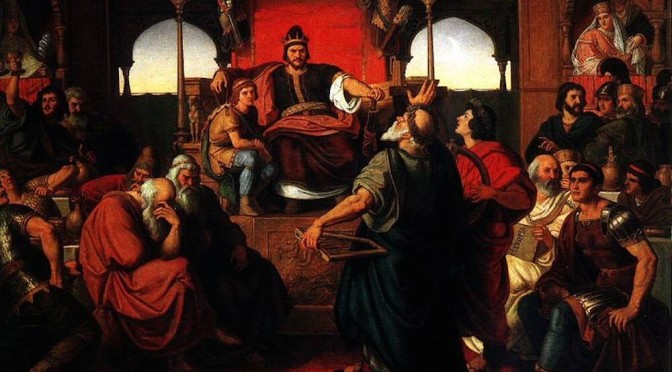The selected elite
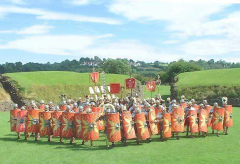 The Romans gained and maintained their empire through a mixture of diplomacy,coercion and brute force.
The Romans gained and maintained their empire through a mixture of diplomacy,coercion and brute force.Usually there was diplomatic contact before invasion to discover who would co-operate and who would not. There were many examples to quote to demonstrate the advantages of agreeing to co-operate.
Romanisation could include providing a selected elite with Roman Citizenship and the benefits of “Civilisation”
Civilisation or Enslavement?
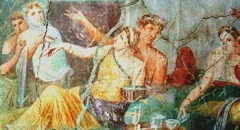 Tacitus wrote of his father in law Agricola, who had led the Romanization of Britain. His comments were presumably to a Roman audience.
Tacitus wrote of his father in law Agricola, who had led the Romanization of Britain. His comments were presumably to a Roman audience.“He [Agricola] wanted to accustom them [the Britons] to peace and leisure by providing delightful distractions. He gave personal encouragement and assistance to the building of temples, piazzas and town-houses, he gave the sons of the aristocracy a liberal education, they became eager to speak Latin effectively and the toga was everywhere to be seen.
And so they were gradually led into the demoralising vices of porticoes, baths and grand dinner parties. The naïve Britons described these things as ‘civilisation’, when in fact they were simply part of their enslavement.’
Barbarian ambition
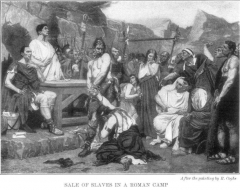 On the other hand, determined unrelenting opposition could lead to the enslavement of entire peoples. Caesar took at least half a million slaves in Gaul and later emperors made similar impacts on the Dacian and Jewish nations.
On the other hand, determined unrelenting opposition could lead to the enslavement of entire peoples. Caesar took at least half a million slaves in Gaul and later emperors made similar impacts on the Dacian and Jewish nations.Nearly everywhere in the Celic world the Romans had been faced with tribes who competed rather than co-operated with each other. The opportunities to divide and rule were readily available.
These tactics continued into the period when they lost control of the Western Empire. The Romans were still convinced that the benefits of civilisation could be extend to the “Barbarians”. The Barbarians however saw an alternative future, one in which they simply took over a ready made empire, or at least parts of it.
Eudoxia
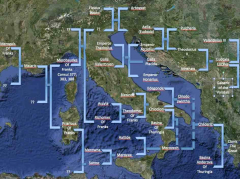 Nevertheless some romanization had already taken place. The lady who married Emperor Arcadius in 395, lived in luxury in Constantinople and had received a Roman Education. She was a Frank. Her name was Aelia but she rapidly changed it to Eudoxia.
Nevertheless some romanization had already taken place. The lady who married Emperor Arcadius in 395, lived in luxury in Constantinople and had received a Roman Education. She was a Frank. Her name was Aelia but she rapidly changed it to Eudoxia.A cursory examination of genealogical record shows that although several of her female ancestors have not been identified, Aelia was the daughter of Flavius Bauto.
Bauto became Magister Militum for the East and died during or just after the battle of the Save . His son Arbogast, Aelia’s brother, became Magister Militum of the West.
Aelia’s grandfather Merobedes, had been a roman consul on at least two possibly three occasions.
This achievement needs to be qualified. Even at this late stage of the Empire the consul was the nominal head of state. In theory The Emperor fulfilled a role approximating tothe role of Prime Minister.
Not only was Merobedes Consul of Rome he was King of the newly established Frankish state within the empire.
The link to Clovis
Merobedes was also an ancester of Clovis the great.
The implication of this is that Clovis the Great, founder of the Frankish realm and facilitator of the survival of the Church of Rome was a close relative of the imperial family.
Clovis the great was closely related the later emperors of Rome?. Can this be true?This is not the genealogy usually quoted and it raises the question as to wether Clovis, or his publicists, wanted to hide such a close relationship. They wanted him to seen barbarian, capable of dreadful acts of violence which would strike terror into the hearts of his enemies.
Fausta
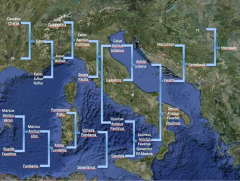 Despite being considered as Franks their ancestry was impeccable. Aelia had Roman ancestors and not just any Romans. A lady known only as Fausta married the Frankish chief Marcomir in 256 when he was in Moesia serving in the roman army under her father. Marcomir was made Roman Dux for the area of Toxandrie, which lies inland of the Rhine/Sheldt estuary and the centre of the area occupied by the Saline (saltwater) and Riparian ( river water) Franks.The family were clearly considered to be Roman. Fausta’s son and grandson rebelled against Rome in the time of the Emperor Constantine and they were both executed as “traitors”.
Despite being considered as Franks their ancestry was impeccable. Aelia had Roman ancestors and not just any Romans. A lady known only as Fausta married the Frankish chief Marcomir in 256 when he was in Moesia serving in the roman army under her father. Marcomir was made Roman Dux for the area of Toxandrie, which lies inland of the Rhine/Sheldt estuary and the centre of the area occupied by the Saline (saltwater) and Riparian ( river water) Franks.The family were clearly considered to be Roman. Fausta’s son and grandson rebelled against Rome in the time of the Emperor Constantine and they were both executed as “traitors”.
It is then perhaps not surprising to find that many other members of the imperial family proposed marriage to “ barbarians”, who might not have been quite so barbarian as the popular image indicates.
The identity of this lady is dependent on the emerging studies of prosopography,which rely on computer matches between naming conventions in different families.
Both sides of Fausta’s family present impressive pedigrees.
Charax
 On Fausta’s mother’s side the line can be followed back to Aulus Julius Claudius Charax .
On Fausta’s mother’s side the line can be followed back to Aulus Julius Claudius Charax .
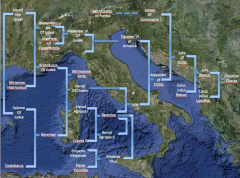 Charax was in turn descended from the Herodians and from Mithridates of Pontus.
Charax was in turn descended from the Herodians and from Mithridates of Pontus.
Descent from Aggrippa
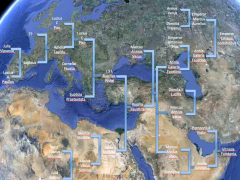 Fausta’s father was of plebeian stock but by the third century the family had provided both senators and consuls. Verus married Rupilla Faustina and both sides of her family lead back to leads back Marcus Vipsanius Aggrippa, who would have succeeded Octavian if he had not died relatively young.
Fausta’s father was of plebeian stock but by the third century the family had provided both senators and consuls. Verus married Rupilla Faustina and both sides of her family lead back to leads back Marcus Vipsanius Aggrippa, who would have succeeded Octavian if he had not died relatively young.
Stichlo
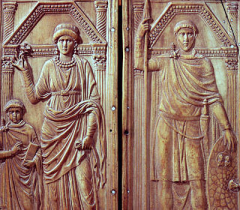 Stilicho took over as magister Militum of the East. Stilicho, a Vandal was also related to the imperial family through his marriage to Serena, the niece of the Emperor Thedosius. Stilicho took over as magister Militum of the East. Stilicho’s son, Eucharius was betrothed to Galla Placida, Thedosius’ daughter.
Stilicho took over as magister Militum of the East. Stilicho, a Vandal was also related to the imperial family through his marriage to Serena, the niece of the Emperor Thedosius. Stilicho took over as magister Militum of the East. Stilicho’s son, Eucharius was betrothed to Galla Placida, Thedosius’ daughter.
We know little of Stilicho’s parents but do know that he was appointed ambassador to parthia in his daly twenties. it is assumed that his mother also must have been close to the imperial family.
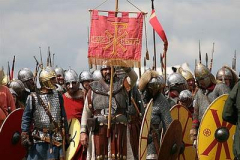 Many of the barbarians had served in the roman army with the result that the army itself became more barbarian but those who served became more Roman. This was especially true of those who reached the upper ranks of the army and mixed with their patrician roman counterparts.
Many of the barbarians had served in the roman army with the result that the army itself became more barbarian but those who served became more Roman. This was especially true of those who reached the upper ranks of the army and mixed with their patrician roman counterparts.
Galla Placida
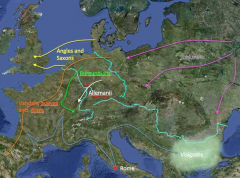 The story continues with the story of of Galla’s Placida who’s life was impacted in 406 by a series of traumatic events. The great migrations of Sweves , Alans, Vandals Burgundians and Alemanii or Stilicho’s dealings with the Goths led to Stilicho’s subsequent execution of Stilcho. Stilcho’s son, Eucharius, to who she was engaged, was then murdered.
The story continues with the story of of Galla’s Placida who’s life was impacted in 406 by a series of traumatic events. The great migrations of Sweves , Alans, Vandals Burgundians and Alemanii or Stilicho’s dealings with the Goths led to Stilicho’s subsequent execution of Stilcho. Stilcho’s son, Eucharius, to who she was engaged, was then murdered.
Alaric had been appointed Magister Militum for Illyrica by the Eastern Emperor Arcadius perhaps because Arcadius suspected Stilicho had plans to move the provice to the Western Empire. Alaric then invaded Italy but withdrew after a negotiated settlement with Stilicho which included a massive payment for his withdrawal. Alaric also provided troops for Stilico’s fight against a British /Gallic revolt headed by Constantine III. At the same time proposed to move his allegiance to the western empireproposed the separation of the whole of Illyrica from the Eastern to the Western empire. it was expected that there would be conflict. during this period many of the families of Alaric’s followers so alaric were settled in Italy.
These events were accompanied with the slaughter of Visigothic families in Italy and Alaric’s subsequent invasion.
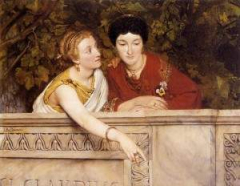 When the Visigoths left Rome, the Emperors daughter, Galla Placida left with them. There is an opinion she went willingly. Four years later she married Autulf , Alaric’s son with great ceremony.
When the Visigoths left Rome, the Emperors daughter, Galla Placida left with them. There is an opinion she went willingly. Four years later she married Autulf , Alaric’s son with great ceremony.
She had at least one, possibly three children by Autulf.
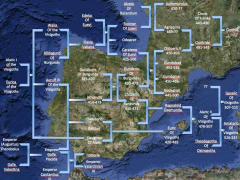 Theodoric, King of the Visgoths, who died fighting the Huns at the battle of the Catalunian plain was probably Galla Placida’s son.
Theodoric, King of the Visgoths, who died fighting the Huns at the battle of the Catalunian plain was probably Galla Placida’s son.
On Aultulf’s death Galla Placida returned to Rome where she married again to the Emporer Constantius III. Constantius and Galla Placida’s son became Emperor Valantinian III and their daughter was Honoria. She became an empress in her own right.
Even after her return to Rome Gallida Placida was always referred to by the Visigoths as “Our Queen”. In Ravenna her personal bodyguard was entirely made up of Visigoths and she made sure they were always treated favourably.
Eudoxia and the Vandals
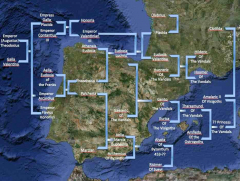 The flight of the female royal blood did not end there. In 455 Valantinian III, son of Galla Placida, married Eudoxia Lucinia the granddaughter of Aelia, Their daughter Eudoxia Valantinia, was betrothed to Hunneric, son of Gaeseric the king of the Vandals, who had established an independent state in North Africa.
The flight of the female royal blood did not end there. In 455 Valantinian III, son of Galla Placida, married Eudoxia Lucinia the granddaughter of Aelia, Their daughter Eudoxia Valantinia, was betrothed to Hunneric, son of Gaeseric the king of the Vandals, who had established an independent state in North Africa.Valentinian was murdered, perhaps in retribution for his rape of Petronius Maximus’ wife Lucina. After murdering her husband Maximus declared himself Emperor and married Eudoxia Lucinia. Unwilling to submit to Maximus, Eudoxia the elder appealed to Gaeseric to rescue her. He responded rapidly and captured Rome. Maximus was killed and when caesuric left he took both Eudoxia’s with him. He married the elder Eudoxia himself and some time later his son did indeed marry Eudoxia Valantinia. The progeny of these two marriages had descenents both in the visigothic kingdom and the later East Roman (Byzantine) Emperors.
By one or both of these events Burgundian, Visigothic and Frankish rulers were all descendants of Galla Placida.
These relationships are the reason that the Salic law, formulated by Clovis, barred succession though a female line and why his family never mentioned Clothilde’s heritage. If they had made any claim dependent on Clothilde’s bloodline it would have opened up similar claims from both Visigoths and Burgundians.by one or both of these events.
Attila and Honoria
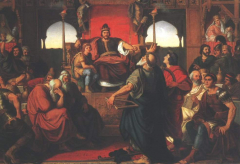 In the meantime Attila had established a principle of protection money from the Eastern Emperor. It was a simple arrangement, in return for a generous payment Attila would not cross the Danube, would nor attack Byzantium. There were frequent diplomatic exchanges between Attila and Byzantium and during one diplomatic mission Priscus, the Byzantine historian recorded in great detail the way that Attila lived. His observations are recorded in a famous painting by Mor Than which is in the Hungarian National Gallery in Budapest.In the meantime Attila the Hun whose empire now impinged on both the Rhine and Danubian frontiers had established a principle of protection money from the Eastern Emperor. It was a simple arrangement, in return for a generous payment Attila would not cross the Danube, would nor attack Byzantium. There were frequent diplomatic exchanges between Attila and Byzantium and during one diplomatic mission Priscus, the Byzantine historian recorded in great detail the way that Attila lived. His observations are recorded in a famous painting by Mor Than which is in the Hungarian National Gallery in Budapest.
In the meantime Attila had established a principle of protection money from the Eastern Emperor. It was a simple arrangement, in return for a generous payment Attila would not cross the Danube, would nor attack Byzantium. There were frequent diplomatic exchanges between Attila and Byzantium and during one diplomatic mission Priscus, the Byzantine historian recorded in great detail the way that Attila lived. His observations are recorded in a famous painting by Mor Than which is in the Hungarian National Gallery in Budapest.In the meantime Attila the Hun whose empire now impinged on both the Rhine and Danubian frontiers had established a principle of protection money from the Eastern Emperor. It was a simple arrangement, in return for a generous payment Attila would not cross the Danube, would nor attack Byzantium. There were frequent diplomatic exchanges between Attila and Byzantium and during one diplomatic mission Priscus, the Byzantine historian recorded in great detail the way that Attila lived. His observations are recorded in a famous painting by Mor Than which is in the Hungarian National Gallery in Budapest.Honoria, Empress, daughter of an Empress, half brother of the Visigoth who now called himself King Theodoric, had proposed marriage to Attila in 450 and sent him her most valuable ring as proof of her scincerity. It was said to be Honaria’s way of avoiding an undesirable marriage. Obviously Attila was interested.
Ellak the Hun
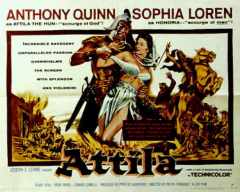 There can be few better introductions to the subject of Attila and the Empress Honoria than this 1954 Hollywood film. It was "historically inaccurate" as there is no record of an actual meeting between Honoria and Attila. However Honoria vanished from the Roman record immediately after Attila's second invasion of the Empire and Attila is supposed to have died of a heart attack during strenuous sexual activity a year later. Who knows?
One version of the Geneology claimed by the Carolingian Kings of the Franks shows that Honoria did have a child, Ellak and that the Carolingians are descended from that child.In AD 441, Attila finally invaded the Empire. Huns poured through the Allamanii lands and swept past the defences of the Franks and the Saxons. Attila made it abundantly clear what he wanted. The hand of the Empress Justa Grata Honoria and half the empire which he judged to be hers by right.
There can be few better introductions to the subject of Attila and the Empress Honoria than this 1954 Hollywood film. It was "historically inaccurate" as there is no record of an actual meeting between Honoria and Attila. However Honoria vanished from the Roman record immediately after Attila's second invasion of the Empire and Attila is supposed to have died of a heart attack during strenuous sexual activity a year later. Who knows?
One version of the Geneology claimed by the Carolingian Kings of the Franks shows that Honoria did have a child, Ellak and that the Carolingians are descended from that child.In AD 441, Attila finally invaded the Empire. Huns poured through the Allamanii lands and swept past the defences of the Franks and the Saxons. Attila made it abundantly clear what he wanted. The hand of the Empress Justa Grata Honoria and half the empire which he judged to be hers by right.There can be few better introductions to the subject of Attila and the Empress Honoria than the 1954 Hollywood film. It was “historically inaccurate” as there is no record of an actual meeting between Honoria and Attila. However Honoria vanished from the Roman record immediately after Attila’s second invasion of the Empire and Attila is supposed to have died of a heart attack during strenuous sexual activity a year later. Who knows?
One version of the geneology claimed by the Carolingian Kings of the Franks shows that Honoria did have a child, Ellak and that the Carolingians are descended from that child.
